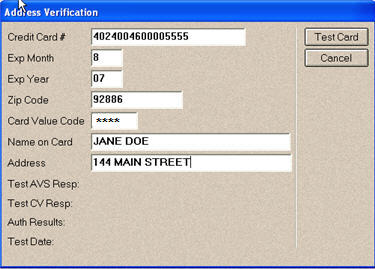
(MOTO AVS users only)
This topic describes what happens when you are processing a mail, phone, or iNet order, and you have purchased the Address Verification (AVS) feature (option 8292 "Allow Address Verification in POS" is set to M-MOTO). The process includes creating a test transaction to verify that the card is good, taking any necessary action if the test displays any warnings, and finally invoicing the transaction.
If you received a phone or mail order, and the customer wants to purchase products for shipment, generate an order in POS (alternatively, you can create a sale if the merchandise will be invoiced immediately). If you are processing an iNet e-Store order, recall the order in POS.
Press Total (+ on the keypad).
If this is an iNet e-Store order, the Address Verification dialog displays automatically. If this is a phone order or mail order, select T-Totals Menu, then select U-Address Verification Test. The Address Verification dialog displays.

Fill in the dialog box, as necessary:
If this is an iNet e-Store order, the dialog is already filled in with the credit card and address information that was provided by the customer when they placed the order on your web site. If you want to enter a Card Value (CV) code, you need to contact the customer for that information, then manually enter the CV code in the Card Value Code field.
If this is a phone or mail order, you must fill in the fields manually, including Credit Card Number, Exp Month, Exp Year, Zip code, Card Value Code, Name on Card, Address.
Press Tab to highlight the Test Card button, then press Enter. The system sends an "authorization only" transaction request for $1.00, as well as the AVS and CV information, to ProtoBase, which submits the transaction to the processor.
![]()
If you have security to do so, you can bypass the Test Card process by pressing Cancel.
Once you've received and read the processor's response to the test, press OK to close the dialog.
At this point, POS submits a "remove authorization" request to ProtoBase. The AVS and CV responses, as well as the card number/expiration date (both encrypted), are saved along with the order.
If the test transaction is approved and the AVS and CV data matches, you can either immediately invoice the transaction, or save it so it can be recalled and billed at a later time.
If the test transaction is approved but receives an AVS or CV response warning, call the customer to obtain revised address information (if you are unable to reach the customer, save the order so you can try again later), enter the new information in the Address Verification dialog, and press Test Card to resubmit the test.
If the transaction still comes back with AVS or CV warnings after resubmitting the test, ask the manager how to proceed. You may be instructed to ignore the warning and submit the card for full tender at invoicing time, require some other form of tender from the customer, or void the transaction.
When appropriate, invoice the order. If a test transaction was executed in step 5 above, the fields in the AVS dialog fill in automatically based on the test transaction (all but the last four digits of the card number are masked). The message "Transaction in AVS Credit Card Tender Mode" displays on the totals screen (at this point, you can change to some other form of tender, if needed). The system compares the AVS and CV responses from the test transaction to the response code actions set up in Options Configuration (in option 8293 "Address Verification Services Response Codes").
If the response code indicates that invoicing is allowed, the clerk can proceed with invoicing.
![]()
The AVS and CV data are not verified during invoicing. Only the "test card" process verifies this information. The only reason the system submits AVS and CV data to the processor during invoicing is to ensure that you receive the best discount rates available on the transaction.
If the response code indicates that invoicing is not allowed (this can be due to AVS response codes, or because successful test results don't exist or have expired), press OK. At this point you must either obtain a manager's override, or perform a test transaction prior to invoicing.

![]()
If you are creating an order for a customer with a stored credit card number, card and address information is automatically passed to POS. Transactions tendered using a stored credit card don't require the AVS response code test, nor does the system check the last test date; rather, it is assumed that if a customer has a stored credit card on file, you have already verified the card is good. Stored credit cards are nevertheless processed as MOTO AVS transactions in order to ensure you get the best discount rate possible from your processor.
If you manually enter a credit card in the totals screen of POS, the system treats the transaction as a retail AVS transaction. The system only flags two types of transactions as MOTO AVS transactions: 1) iNet credit card transactions and 2) transactions where the clerk attempts an AVS test . If you enter a new credit card on the Totals screen for an iNet order or for a transaction for which a MOTO AVS test has previously been run, the system clears any previous MOTO AVS data / iNet flags and the transaction processes as a retail AVS transaction.